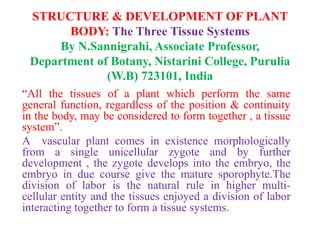
Sem iii(h)4
- 1. STRUCTURE & DEVELOPMENT OF PLANT BODY: The Three Tissue Systems By N.Sannigrahi, Associate Professor, Department of Botany, Nistarini College, Purulia (W.B) 723101, India “All the tissues of a plant which perform the same general function, regardless of the position & continuity in the body, may be considered to form together , a tissue system”. A vascular plant comes in existence morphologically from a single unicellular zygote and by further development , the zygote develops into the embryo, the embryo in due course give the mature sporophyte.The division of labor is the natural rule in higher multi- cellular entity and the tissues enjoyed a division of labor interacting together to form a tissue systems.
- 3. Type of Tissue systems • The arrangement of cells and tissues in the plant body maintain topographic continuity or physiologic similarity, or both together. The units are called tissue systems. Each system usually consists of one tissue or in Association of tissues which perform a common function and have the same origin. According to Sachs(1875), the three main tissue system are recognized- • 1. The dermal or Epidermal tissue system, • 2. The fundamental or ground tissue systems, • 3. The Vascular tissue systems
- 4. The Epidermal Tissue System • The Epidermal tissue systems derived from the Epidermis(Permanent tissue)-a derivative of protoderm (Meristematic tissue). • The protective covering of the plant body, primarily as epidermis and in course of secondary growth as periderm. • The epidermis undergone modifications to form series of structure-Stomata. Trichomes, Bulliform cells, salt glands etc. • Epidermis generally derived from protoderm or dermatogens or tunica(Opinion differs), single layered but multiple- epidermis(Ficus, Nerium), Velamen as Orchid root, thin walled but thick lignified wall as gymnosperms, may be cuticularised or waxy, horizontally flattened and remain parallel to surface of the organ without intercellular spaces, calcium crystals of the epidermis called Cystoliths or lithocysts, have silica deposition in the bracts of rice etc.
- 5. How does it look?
- 6. Different types------- • Epidermal hairs-Present in roots, stems, leaves, floral parts, seeds, stamens • Trichoblasts protrude to form unicellular or multi- cellular root hairs, stellate or dendroid or papillae. • Bulliform cells-Large epidermal cells in monocot leaves, fan shaped appearance, thin walled, hyaline, cuticularised to unroll leaves, periodical turgor pressure change for opening and closing of mature leaves, mechanical rigidity due to cuticularisation. • Stomata-a pair of guard cells having the diurnal changes of water potential value
- 7. Epidermal------ • As far position • Amphistomatous-Both the surface fewer on the upper surface • Hypostomatous-only on the lower surface( Ficus) • Epistomatous-Only on the upper surface specially on free floating leaves( Nympheae) • Stomatal frequency(Number of stomata per unit area) varies species wise • Stomatal frequency= Stomatal frequency/Number of stomata+number of epidermal cells per unit area*100
- 10. GROUND TISSUE SYSTEMS • The ground or fundamental tissue systems consists of main bulk of plant body and extends from below epidermis to the centre, leaving vascular bundles apart. The cortex, medullary or pith rays, endodermis, pericycle and pith are the site of the distribution of ground tissues. • CORTEX: Usually the cortex consists of thin walled parenchyma cells with abundant intercellular spaces with starch, tannins, crystals and other common substances, it may be collenchymas sclerenchyma and sclerides , very often hypodermis present .Collenchymas develops early but sclerenchymatous cells are usually late in maturity.
- 11. Ground tissue systems • ENDODERMIS: Delimiting the cortex from stele, uniseriate, barrel-shaped cells arranged quite close to each other without intercellular spaces-primary thin walled & secondary thick walled (Casparian strips).Among the thick walled cells of endodermis, in roots, isolated thin walled cells usually opposite to the protoxylem elements called passage or transfusion cells. • Sort of accessory inner epidermis for protection • Acts as an air dam to prevent diffusion of air into vessels and escape from closing • Storage
- 12. Ground tissue • PERICYCLE: Thin cylinder of tissue completely encircling the vascular bundles and the pith, mostly parenchyma but pericyclic fibres(Cannabis, Linum) • In dicot roots, pericycle becomes meristematic to form vascular cambium and phellogen but some storage tissues like Laticiferous cells, secretory cells and other specialised cells may remain also present. • PITH: Central region of root & stem, the extensions of pith in the form of narrow parenchymatous strips called medullary rays or pith rays , possess tannin and crystal, serve as mechanical and storage.
- 14. VASCULAR TISSUE SYSTEMS • Consists of number of vascular bundles found to be distributed in the stele • Each VB consists of xylem & phloem, Radial, conjoint or Concentric;, Open or closed ; Endarch or exarch; • The function of the system is to conduct water and other nutrients from roots to leaves through the xylem and translocation of the prepared carbohydrates from leaves to the other storage organs and growing regions of the plant body through the phloem • Cortical bundles are those with cortex enriched with VB.
- 15. Thank you for your journey